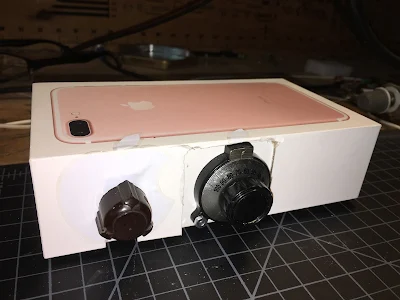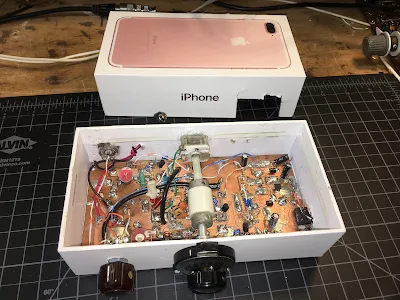Serving the worldwide community of radio-electronic homebrewers. Providing blog support to the SolderSmoke podcast: http://soldersmoke.com
Podcasting since 2005! Listen to our latest pocast here:
Podcasting since 2005! Listen to Latest SolderSmoke
Thursday, November 30, 2017
VK3YE QRP by the Bay Goes VHF/UHF
Peter Parker again hosted the VK3 radio amateurs. This time the event fell on VHF/UHF Field Day weekend. So Peter and his friends went up in frequency and up into SPACE!
VK3HN has a nice blog post here:
https://vk3hn.wordpress.com/2017/11/25/qrp-by-the-bay-chelsea-beach-melbourne-25-11-2017/
Be sure to read about Peter's ankle manacles -- he apparently uses them to get a good ground (sea) plane while running pedestrian mobile on the sea shore. Peter is DEDICATED!
Wednesday, November 29, 2017
Listening for Your Own Signals on the Long Long Long Path
From: http://qrznow.com/the-w8jk-is-a-famous-and-effective-dx-antenna/
Round-the-world paths The bi-directional nature of this antenna makes it possible to discover open round-the-world paths, something not possible with a normal beam antenna. The technique used by Kraus is to rotate the beam slowly, sending short Morse code dots, with a full-break-in or QSK transceiver
Tuesday, November 28, 2017
Videos of iPhone Box DC Receiver
These are just a couple of short videos that I made for my nephew before sending him this receiver.
As you can hear, deafness is not a problem with this design! I did make some frequency stability improvements after this video was made -- I think you can hear a bit of drift. Still, not bad for a very simple circuit using a polyvaricon superglued to the back of a cardboard box.
I'll post more videos of the second version of this receiver. There are further improvements in frequency stability. My goal: "Juliano Si5351" levels of stable-ness.
Saturday, November 25, 2017
Polyvaricon Variations -- Polyvaricons Are Not all The Same
When I built the first prototype of the iPhone DC receiver, I just reached into my junk box and used a polyvaricon capacitor for the main tuning control. It was marked PL 051. I was really pleasantly suprised at the stability of the Variable Ceramic Oscillator circuit. I could tune the entire 40 meter band with complete stability -- Juliano levels of stability.
Has anyone else noticed variations like this in the stabilty of polyvaricons?
The dial in this version is an Archer device that has been kicking around in my junkbox for more than 20 years. I think it was given to me by my old friend Pericles HI8P -- this adds a tremendous amount of soul to this new machine). The box is an old Bud aluminum chassis. Man, this thing sounds great. I will try to post a video soon.
Wednesday, November 22, 2017
iPhone Direct Conversion Receiver with Variable Ceramic Oscillator
A while back Bob N7SUR got us talking about winter projects. Receivers. Of course, Pete and I quickly went down different paths. Pete is making great progress with lots of interesting digital circuitry. He is going over to the dark side. Check it out here:
I went with simplicity. Extreme simplicity. Direct Conversion (thanks Wes!). Discrete components. No chips. Analog Oscillator. 40 meters -- monoband.
 |
| Schematic updated 29 November 2017 |
There it is. You can click on the picture to make it larger. Here is an outline of the circuitry:
-- Single tuned circuit bandpass filter preceded by a simple pot that serves as a gain control.
-- JFET RF amp
-- Singly balanced passive mixer inspired by F5LVG's RX-20 in SPRAT 100. For the coil I used one of the many trifilar toroids that Farhan gave me.
-- The local oscillator is the coolest stage. I used a 7.37 MHz ceramic resonator and a circuit inspired by Miguel PY2OHH. With a polivaricon I can tune the entire 40 meter band. I put a reduction drive int here to make tuning easier.
-- The AF amp is an op-amp free design. It works well into ear buds or into a computer speaker.
-- Perhaps in an effort to catch the attention of the younger generation, I built it into an iPhone box.
Please let me know if you spot any flaws in the circuit, or see any places where it might be improved.
More to follow. This prototype is now in the mail, en route to my nephew John Henry who will be testing it for me.
Saturday, November 18, 2017
China and SETI: What Happens if China Makes First Contact?
Here is a really amazing article from The Atlantic. It is very thought provoking. Mind blowing. Strongly recommended.
You can read it here:
https://www.theatlantic.com/magazine/archive/2017/12/what-happens-if-china-makes-first-contact/544131/
Or you can listen to a reading of it (like a podcast) here:
https://soundcloud.com/user-154380542/what-happens-if-china-makes-first-contact-the-atlantic-ross-andersen
Thanks to Mike Rainey AA1TJ for alerting us to this.
Friday, November 17, 2017
Jeff Murray's Grumpy Audio Guy from 40 meters
I've talked to this guy several times. He usually waits until I'm testing a new rig.
https://www.facebook.com/6sj7jeff/videos/10208309648978285/
I'm sure Pete has worked him too.
https://www.facebook.com/6sj7jeff/videos/10208309648978285/
I'm sure Pete has worked him too.
Saturday, November 11, 2017
Amazing Homebrew/Boatanchors QSOs on 40 --Six solder melters in a row!
 |
| Al W8VR |
After a day of happy tinkering with the Direct Conversion receiver I've been working on, I turned off the soldering iron and got on 40 meter SSB with my BITX Digi-Tia.
First -- Steve W4IJ came back to my CQ. Steve is a boatanchor enthusiast and has written for Electric Radio magazine. FB.
 |
| W4IJ Boatanchors |
When Steve signed off, I got into a contact with Pete W8NBO. We had spoken before and he had told me of a homebrew transmitter he'd built as a kid. This time I asked for details: It was a 6AG7 oscillator to a 6L6 amplifier. He ran it with an S38 (brave man!). He described what must have been a very painful effort to hack (literally) the needed holes in the transmitter chassis using just a spike, a hammer and a file. I told him this brought back my memories of similarly painful chassis work (mine was for a power supply for a Heath HW-32A).
At this point we were joined by Arnie, W2HDI. Arnie's rig is in Stowe Vermont, but he was running it remote from the South of France where he and his wife were celebrating their 50th wedding anniversary. Arnie shared with us memories of similar chassis pain -- his were related to an external modulator that he built for a DX-40. I think he said that all he had was a hole punch and a file. Oh, the humanity!
Then Al W8VR joined the conversation. Al said that he's been in the game so long that his early rigs were built using cigar boxes as chassis. I pointed to a connection: I noted that my BITX rigs are enclosed in what could be considered cigar boxes. Al's QRZ page picture has a magnificent AM rack rig that he said was actually built twice. There is also an HRO-60 in the picture. FB. Check it all out at Al's web site. Click on the mic for the write ups, the key for the pictures. http://www.w8vr.org/
Then Dennis K0EOO called in. Holy Cow! Dennis and I spoke not long ago. You may recall my enthusiastic write up of his beautiful 1974 SSB rig:
and
This was almost too much. Rarely will you spontaneously come across so many hams who have melted so much solder. FB.
Icing on the cake: When I returned to the bench, I fired up the DC receiver and heard Mike KN4EAR talking about his BITX40. I switched to the Digi-Tia and gave Mike a call. He reports making many contacts with his rig. FB.
TRGHS.
Wednesday, November 8, 2017
Beautiful QSL by Jeff Murray K1NSS
Here's a reminder of the amazing art work of Jeff Murray K1NSS.
You can have him draw a QSL for you: Go here:
https://www.jeffk1nss.com/
Well, I got as far as high school intermediate algebra and then I saw a squirrel.
Thank goodness others like Ken N2WWD were paying attention and went on to surf gravity's rainbow of flight dynamics, all in a day's work and play for rocket scientists. Tandem surfing and professional activities somewhat aside, Ken is also actively involved with ARISS, i.e. Amateur Radio on the International Space Station, the group guiding ham radio operations aboard ISS. So Kelvin cool to work with Ken on this New One, with Ken cooking up a special Easter Egg for all you galactic hitchhikers!
What might I draw with you?https://www.jeffk1nss.com/
What might I draw with you?https://www.jeffk1nss.com/
Monday, November 6, 2017
Jan's FB Slovakian SMD TIA Boards
Hello,
I have put up my SMD version of the TIA amplifier boards online, in case
someone wants it. The files are here:
and direct OSHPark order link:
73!, Jan
Sunday, November 5, 2017
Saturday, November 4, 2017
Termination Insensitive Amp Boards from VU3ZMV -- Eagle Files

Here are the eagle file data for the TIA, that I love to use as incorporated in Farhan's ubitx.
The TIA , I tried to realise two such on a double sided pcb measuring less than an inch.
The Ham-Radio Thermatron Roots of Silicon Valley
Hack-A-Day had an excellent piece on tubes and Silicon Valley this week. Makes me want to get the book "Secret History of Silicon Valley."
https://hackaday.com/2017/11/02/silicon-valley-was-built-on-tubes-of-glass/
Note above the Klystron prototype mounted on a wooden board. These guys clearly had THE KNACK.
Friday, November 3, 2017
Another Source for BITX Amp Boards - AG4ZP
Thanks for sharing (the infor on the modular BITX boards). I actually had a similar idea a number of years ago and designed a small PCB for the ubiquitous BITX amplifier design. I have the project shared on OSH Park and you can get three of them shipped for $5.
The project is shared here.
73,
Ryan AG4ZP
https://oshpark.com/shared_projects/6mnfQQ6e
Subscribe to:
Comments (Atom)











